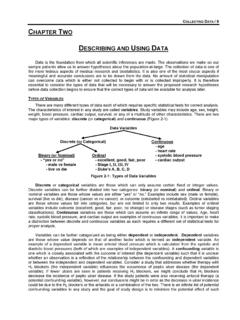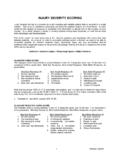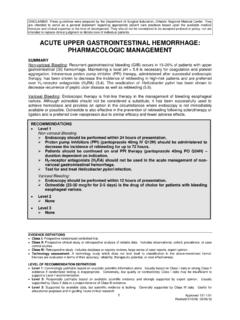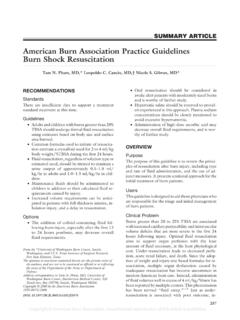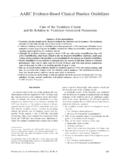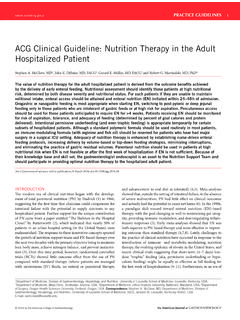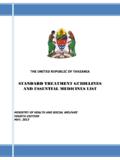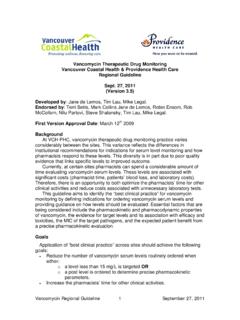Transcription of Hypothermia in Burn Patients - surgicalcriticalcare.net
1 DISCLAIMER: These guidelines were prepared by the Department of Surgical Education, Orlando Regional Medical Center. They are intended to serve as a general statement regarding appropriate patient care practices based upon the available medical literature and clinical expertise at the time of development. They should not be considered to be accepted protocol or policy, nor are intended to replace clinical judgment or dictate care of individual Patients . EVIDENCE DEFINITIONS Class I: Prospective randomized controlled trial. Class II: Prospective clinical study or retrospective analysis of reliable data. Includes observational, cohort, prevalence, or case control studies. Class III: Retrospective study. Includes database or registry reviews, large series of case reports, expert opinion.
2 Technology assessment: A technology study which does not lend itself to classification in the above-mentioned format. Devices are evaluated in terms of their accuracy, reliability, therapeutic potential, or cost effectiveness. LEVEL OF RECOMMENDATION DEFINITIONS Level 1: Convincingly justifiable based on available scientific information alone. Usually based on Class I data or strong Class II evidence if randomized testing is inappropriate. Conversely, low quality or contradictory Class I data may be insufficient to support a Level I recommendation. Level 2: Reasonably justifiable based on available scientific evidence and strongly supported by expert opinion. Usually supported by Class II data or a preponderance of Class III evidence. Level 3: Supported by available data, but scientific evidence is lacking.
3 Generally supported by Class III data. Useful for educational purposes and in guiding future clinical research. 1 Approved 03/29/2018 2018 All rights reserved. PERIOPERATIVE Hypothermia PREVENTION IN burn Patients SUMMARY Perioperative Hypothermia is associated with serious morbidity including blood loss, surgical wound infections, and death. Maintaining euthermia in the burn patient is especially challenging due to the need for significant and prolonged skin exposure to facilitate debridement and skin grafting. Thermoregulation in the operative setting can be accomplished through environmental warming (adjusting the room temperature), cutaneous warming (blankets, forced-air and warm-water circulating devices), and internal warming (intravascular catheters and esophageal warming catheters).
4 INTRODUCTION Perioperative Hypothermia is associated with significant morbidity (including increased blood loss and surgical wound infections) and potential mortality. Maintaining euthermia in the burn patient is especially challenging due to the need for prolonged and sometimes extensive skin exposure to facilitate debridement and skin grafting. Thermoregulation in the operative setting can be accomplished through a variety of techniques including environmental warming (adjusting the temperature of the operating room), cutaneous RECOMMENDATIONS Level 1 None Level 2 burn operating rooms should be pre-warmed to at least C (76 F) and adjusted according to the patient s total body surface area (TBSA), patient response, and procedure length.
5 All adult burn Patients should receive warmed intravenous fluids if >500 mLs is administered. All adult burn Patients with injuries greater than 10% TBSA should be placed on a water-fluidized warming blanket. Level 3 Esophageal or intravascular warming devices should be considered for Patients who: Have greater than 20% TBSA partial and/or full thickness burns Have an anticipated operative time greater than 3 hours Esophageal warming devices may be considered EXCEPT in Patients with esophageal pathology or with extensive head/neck edema that interferes with safe esophageal intubation for 5 days post-operatively Esophageal warming devices can be set to a maximum of 42 C Intravascular warming catheters should be considered for placement the day prior to planned surgery and removed as soon as no longer clinically indicated.
6 Intravascular warming devices can be set to a maximum of 42 C Forced air warming devices should not be placed directly on burn wounds 2 Approved 03/29/2018 2018 All rights reserved. warming (blankets, forced-air and warm-water circulating devices), and internal warming (intravascular catheters and esophageal warming catheters). This guideline details the morbidity associated with Hypothermia in burn Patients with the specific focus of preventing Hypothermia in the perioperative setting. BACKGROUND The hypothalamus normally regulates temperature through efferent responses. Behavioral responses require a conscious state not possible during general anesthesia. Autonomic responses can lead to vasoconstriction or perspiration which may be significantly altered during general anesthesia.
7 This occurs primarily due to the vasodilatory effects of anesthesia opposing normal thermoregulatory mechanisms (1,2). Primary Hypothermia is caused by environmental exposure to cold, whereas secondary Hypothermia results from inadequate physiologic heat production. Advanced Trauma Life Support (ATLS) classifies core temperature Hypothermia as mild (32 35 C), moderate (30 32 C), or severe (<30 C). In contrast to severe environmental Hypothermia , which is associated with a mortality rate of <25%, even moderate Hypothermia associated with severe traumatic injury is associated with a nearly 100% mortality risk (3). burn Patients are at increased risk for Hypothermia due to unprotected and prolonged body surface exposure and loss of protective thermoregulation provided by normally intact skin (2).
8 The risk for Hypothermia increases exponentially during the resuscitation phase and surgical intervention. Hypothermia can lead to increased wound infections, prolonged hospital length of stay, and worsened post-operative discomfort. Myocardial morbidity may occur with only mild Hypothermia . burn Patients undergoing excision of large burn wounds are at risk for increased blood loss, coagulopathy and death (1). Maintaining euthermia aids in the extubation process and decreases the risk of shivering (4). This morbidity does not end with the operating room as burn Patients may remain hypothermic post-operatively and require ongoing monitoring and treatment in a critical care setting (5). The morbidity and mortality associated with Hypothermia necessitate aggressive intervention, most especially during the critical operative phase of burn treatment.
9 Williams et al. described three warming categories. First, maintaining a warm environment allows for endogenous heat production. Second, active cutaneous warming of the body s surface can be accomplished through multiple modalities. Third, internal rewarming of the body s core is possible using intravascular warming catheters and esophageal heat exchange devices (EHED) (5,6). Regardless of the modality selected, accurate monitoring of core temperature is essential (7). LITERATURE REVIEW The massive inflammatory response to a major burn leads to increased oxygen consumption, catabolism, and resting energy expenditure. burn -induced hypermetabolism leads to ineffective thermoregulation. Anesthesia administration exacerbates this response and intensifies the heat loss through redistribution of circulating volume.
10 Hypothermia adds further to the metabolic stress. burn injuries result in increased evaporative losses and often require extended operative times (8). The first approach in preventing intraoperative Hypothermia is to warm the environment. Unfortunately, there is extensive heterogeneity within the literature addressing warming of the operating room. Research involving orthopedic surgery suites heated to 25 C and general surgery suites heated to 24 C reveal decreased vasoconstriction and better maintenance of core body temperature. Increasing ambient temperature in the operating room is a common practice in burn surgery. Temperature settings are based on the age and severity of the burns and range between C and C. The effects of these temperatures are exacerbated when donning surgical garb and are oppressive for the staff, creating an environment that hinders performance.



